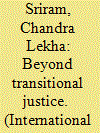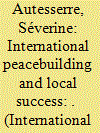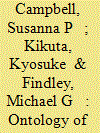|
|
|
Sort Order |
|
|
|
Items / Page
|
|
|
|
|
|
|
| Srl | Item |
| 1 |
ID:
152813


|
|
|
|
|
| Summary/Abstract |
Transitional justice measures are frequently expected to help promote peace in conflict-affected countries, through measures that rely heavily upon legal or legalized processes such as trials and commissions of inquiry. They are also often expected to influence or promote reform in legal processes and institutions, including the judiciary, the constitution, and legislation, in ways that are expected to help promote peace in future post-conflict states. However, not only is the evidence of the role of law in promoting peace through transitional justice a mixed one, but more importantly, the emphasis on transitional justice often overlooks the ways in which law is expected to play a role in promoting peace more broadly and in ways intertwined with transitional justice, through rule of law promotion, often by international actors, and through peace agreements that include specific institutional and governance measures, including power-sharing arrangements. These rule of law and governance measures similarly have a mixed record with regard to their effects for either short- or long-term peace. Closer analysis of the role of law and legalized mechanisms in producing or supporting peace is needed, including analysis of the types of law and mechanisms deployed. Drawing on fieldwork in Sierra Leone, Uganda, Colombia, Kenya, Sri Lanka, and Sudan, among others, this paper will elaborate on the challenges of using law for peace via governance and rule of law measures, as well as through transitional justice.
|
|
|
|
|
|
|
|
|
|
|
|
|
|
|
|
| 2 |
ID:
152814


|
|
|
|
|
| Summary/Abstract |
Violent conflict clearly has devastating impacts on the health of civilian populations. These impacts range from civilian casualties as a result of the inadvertent or deliberate targeting by conflict protagonists to the indirect effects on population health that result from the disruption of health infrastructure and socio-economic systems. Medical interventions, the provision of lifesaving interventions to reduce the suffering of civilians and limit the loss of life during war, are therefore central to humanitarian assistance and an important component of international engagement in conflict-affected states. International humanitarian law (IHL) includes provisions to ensure that civilians are able to access this medical assistance during violent conflict.
|
|
|
|
|
|
|
|
|
|
|
|
|
|
|
|
| 3 |
ID:
152816


|
|
|
|
|
| Summary/Abstract |
Existing research on war and peace lacks analysis of what allows peacebuilding to succeed at the subnational level. Instead, most scholars focus on peacebuilding failure and macro-level dynamics. This is unfortunate because the obstacles to peacebuilding are such that the most puzzling question is why international efforts sometimes succeed, rather than why they fail. The lack of focus on success is also problematic because it results in ambiguous findings. On the one hand, there is an emerging consensus that local conflict resolution is crucial to building peace. There is also an agreement that, all else being equal, international support tends to increase the chances of successful peacebuilding. On the other hand, when international actors have tried to back local initiatives, they have often generated counterproductive consequences and worsened the situation. Should international actors support local peacebuilding processes? If so, how can they actually do this?
|
|
|
|
|
|
|
|
|
|
|
|
|
|
|
|
| 4 |
ID:
152810


|
|
|
|
|
| Summary/Abstract |
The 2016 Presidential Theme for the International Studies Association’s Annual Conference was “Exploring Peace.” This Presidential Special Issue presents some of the innovative ways that scholars are “exploring peace” as more than just the absence of war. In this Introduction, we outline the central ideas behind the theme and show how the research in this Special Issue represents a new way of conceptualizing and studying peace. By expanding the definition of peace beyond the absence of war, the articles in this Issue provide insights into the ways that people do and do not experience peace in their quotidian lives. The works also illustrate how a broader conceptualization of peace can contribute to both IR scholarship and practice.
|
|
|
|
|
|
|
|
|
|
|
|
|
|
|
|
| 5 |
ID:
152811


|
|
|
|
|
| Summary/Abstract |
This article examines the possibilities of interaction and collaboration between top-down and bottom-up indicators of peace. It is based on the Everyday Peace Indicators project an experimental research project that operated in local communities in four sub-Saharan countries. The article begins by making the case for bottom-up approaches to the study of peace, conflict and security. It goes on to scope out the opportunities and obstacles for comparison between bottom-up and top-down indicator systems and looks at three issues: comparability, commensurability and complementarity. It draws on four well-know measurements of peace, conflict and development: the Human Development Index (HDI), the Global Peace Index, the Uppsala Conflict Data Program's Georeferenced Event Data (UCDP GED), and the Armed Conflict Location and Event Data Program (ACLED). We argue for a plurality of vantage points from which to measure peace and conflict.
|
|
|
|
|
|
|
|
|
|
|
|
|
|
|
|
| 6 |
ID:
152815


|
|
|
|
|
| Summary/Abstract |
International relations scholarship on intrastate peace and conflict largely conceptualizes peace as an absence of war and, to some extent, the presence of a minimal degree of democracy. Empirically, scholars treat peace as a non-event, identifying it as the absence of military battles rather than (or in addition to) the presence of conflict-mitigating institutions or activities. This approach hearkens back to a bygone debate about negative and positive peace, and illustrates that negative peace conceptualizations dominate existing scholarship. In this article, we unpack the conceptual foundations of peace to account more fully for cooperation, rather than just violent conflict. We then operationalize this expanded conceptualization of peace through a latent variable measurement approach that carefully aggregates both conflict and cooperation events. We ground the measurement model in data from Colombia for the period of 1993 to 2012. In so doing, we present a new, empirically grounded ontology of peace that we expect could be useful for causal theorizing and testing in other work.
|
|
|
|
|
|
|
|
|
|
|
|
|
|
|
|
| 7 |
ID:
152812


|
|
|
|
|
| Summary/Abstract |
Peace researchers have recently started to develop datasets that allow distinguishing between different levels of interstate peace. In this article, I first argue that existing conceptualizations and measurements suffer—to varying degrees—from two major specification problems: on the one hand, they face problems of what I call “ontological underload,” as they do not include all essential constitutive dimensions. On the other hand, they face problems of “ontological overload,” as they integrate factors as endogenous dimensions that should better be understood as exogenous causes of different levels of peace. I propose a new concept P* that avoids both problems. P* is based on a profound and parsimonious ontology that allows for straightforward theory formulation and empirical analysis. It incorporates three dimensions—behavior, expectations, and duration/stability—that allow us to differentiate between different levels of interstate peace. In this article, I also discuss how P* can be operationalized for a dataset of 126 dyads.
|
|
|
|
|
|
|
|
|
|
|
|
|
|
|
|
|
|
|
|
|